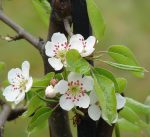T he domestic apple is a deciduous tree native to central Asia and has been grown for thousands of years in Asia and Europe. The trees grow 6-15′ tall in cultivation and up to 30′ tall in the wild. The trees are well branched and have smooth gray bark with raised lenticels. The dark green, elliptical to ovate leaves are 3-6″ long, have raised veins on their underside, and may be softly hairy. Cymes of 4-6 white flowers tinged with pink appear in the spring. Each flower is saucer-shaped, 1-3″ across, and has 4-5 petals. The central flower of the cyme, the “king bloom” opens first and may develop a larger fruit. Fruits vary in color, texture, taste and culinary use. Photo Credit: Wikipedia
he domestic apple is a deciduous tree native to central Asia and has been grown for thousands of years in Asia and Europe. The trees grow 6-15′ tall in cultivation and up to 30′ tall in the wild. The trees are well branched and have smooth gray bark with raised lenticels. The dark green, elliptical to ovate leaves are 3-6″ long, have raised veins on their underside, and may be softly hairy. Cymes of 4-6 white flowers tinged with pink appear in the spring. Each flower is saucer-shaped, 1-3″ across, and has 4-5 petals. The central flower of the cyme, the “king bloom” opens first and may develop a larger fruit. Fruits vary in color, texture, taste and culinary use. Photo Credit: Wikipedia
The apple tree is mentioned in 6 verses of the Bible, all in the Old Testement. Scholars have argued about the translation of the Hebrew word תַּפּ֫וּחַ as it can mean apricot, quince, or orange in addition to apple. Apple trees need a certain number of hours of cold in order to produce fruit so it is unlikely that apples were grown in Israel due to the heat but they were known in Israel and definately grown in Lebanon. Notice that the apple does not appear in the story of Adam and Eve in the Garden of Eden. The fruit of the Tree of Knowledge forbidden to them is the Hebrew word פֶּ֫רִי and is a generic term for fruit. Scholars have argued about the fruit that was meant and although apple is a possibility it is not a certainty.
Other passages in the Bible contain a word that is translated as apple such as apple of the eye, but do not refer to the fruit so have not been included here.
Proverbs 25.11 (KJV) From Hezekiah’s collection of Solomon’s proverbs
“A word fitly spoken is like apples of gold in pictures of silver.”
Song of Songs Also called the Song of Solomon, and Canticle of Canticles, this poem is about the spiritual and sexual love between one man and one woman and describes courtship and marriage customs of the times. Although it is sensual it is also interpreted in religious terms as the relationship between God and Israel, or as an allegory of Christ and his bride, the Church.
2.3, 5 (KJV) The bride speaks to her bridgroom.
3.“As the apple tree among the trees of the wood, so is my beloved among the sons. I sat down under his shadow with great delight, and his fruit was sweet to my taste.”
5.“Stay me with flagons, comfort me with apples: for I am sick of love.”
7.8 (KJV) The bridgroom responds to his beloved.
“I said, I will go up to the palm tree, I will take hold of the boughs thereof: now also thy breasts shall be as clusters of the vine, and the smell of thy nose like apples;”
8.5 (KJV) The friends of the bride ask her a question and the bride replies.
“Who is this that cometh up from the wilderness, leaning upon her beloved?”
“I raised thee up under the apple tree: there thy mother brought thee forth: there she brought thee forth that bare thee.”
Joel 1.12 (KJV) The prophet, Joel, urges the Jews to repentance, fasting, and prayer as they face the results of the locust plague.
“The vine is dried up, and the fig tree languisheth; the pomegranate tree, the palm tree also, and the apple tree, even all the trees of the field, are withered: because joy is withered away from the sons of men.”
Apple trees like full sun to partial shade in average, medium moist, well-drained soil in USDA Hardiness zones 6-9 but must have a certain numbers of hours of cold in order to produce fruit. Propagation is by seed or grafting. Apple trees are susceptible to many pests and diseases including mildew, apple scab, fire blight, black spot, aphids, coding moths and apple maggots.
The genus name, Malus, is the Latin name for the plant. The specific epithet, domestica, comes from the Latin word domus meaning home, and refers to the fact the plant is cultivated.
Light: Full sun to part shade
Soil: Average, medium moist, well-drained
Hardiness: Zones 3-8 (Different varieties have different chilling requirements for flowering and fruit set)
Care: Extensive spraying program needed for good yieled. Plant different varieties near each other.
Pests and Diseases: Numerous including mildew, apple scab, fire blight, black spot, aphids, coding moths and apple maggots.
Propagation: Seed, grafting